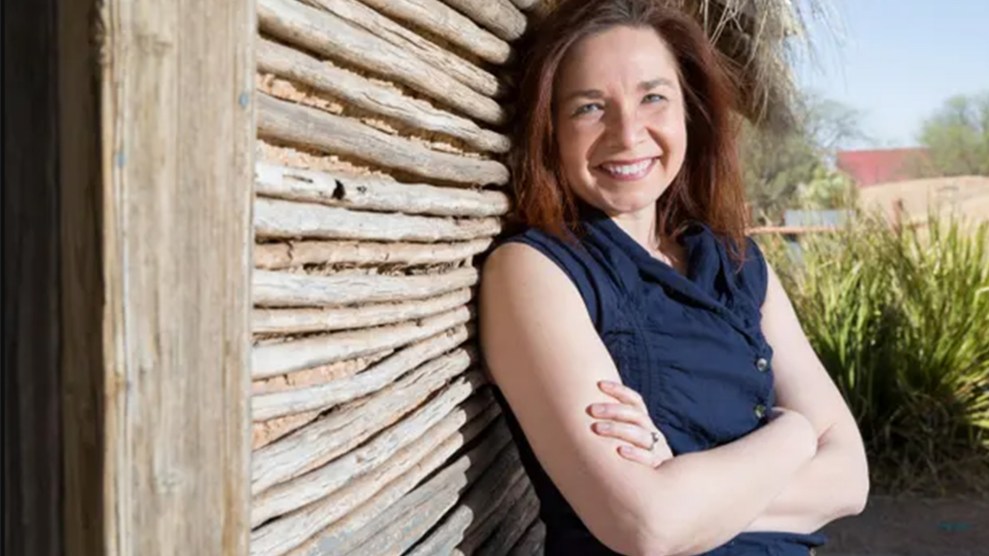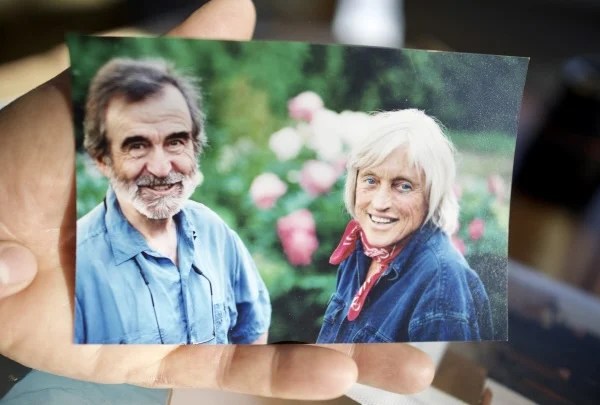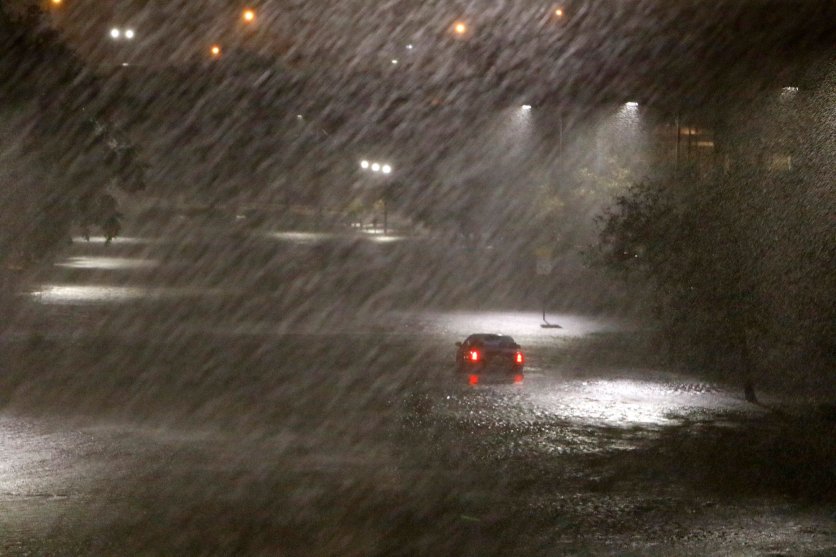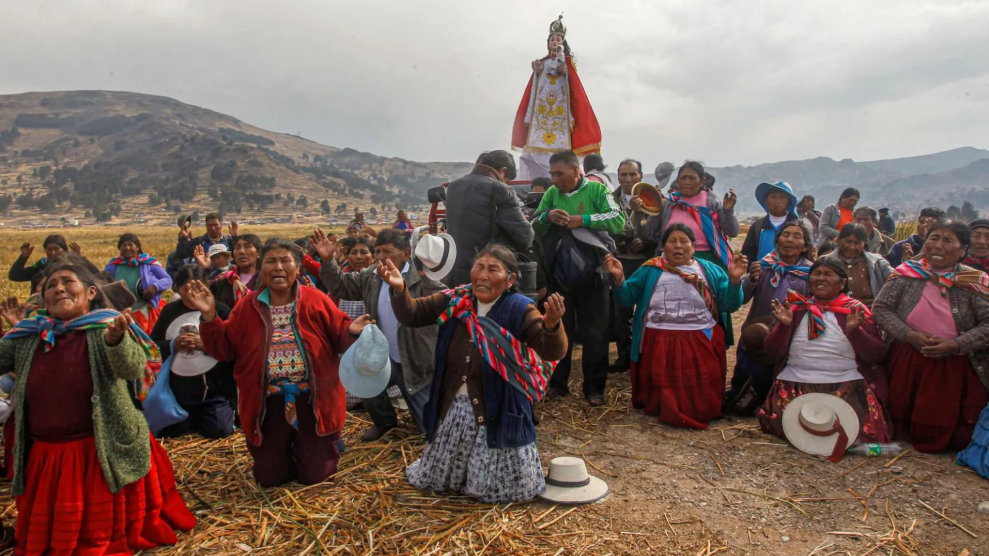
Members of the Aymara community of Ichu pray and take the Virgin of the Clouds on a pilgrimage to ask for rain in the area due to the drought they are facing in Puno, southern Peru, on November 28, 2022.Juan Carlos Cisneros/ AFP via Getty Images
This story was originally published by Grist and is reproduced here as part of the Climate Desk collaboration.
This story was co-published with Sojourners, a nonprofit publication covering faith, politics, and social justice.
Rabbi Dean Shapiro recalls considering the future as he looked down at a baby’s head while giving her a Hebrew name and welcoming her into the covenant of Israel. She was born into a megadrought in Arizona that is only getting worse. As one infant after another is welcomed into his congregation, he finds himself reflecting on their future well-being amid a growing climate emergency. If this child spends her entire life in Phoenix, she could experience 146 days each year with a heat index topping 100 degrees by the time she reaches 30.
As he pondered that eventuality, Shapiro could not help but think that life for this newborn will not look like it did for her parents or grandparents. Rising temperatures will impact the food supply, increase migration, and create other challenges, he thought. Less fortunate children around the world will surely face even worse.
“So, I thought, how do I bless this child in a way that both honors the wonder and miracle and celebration that is this moment but also acknowledges there is pain coming?” he said.
Part of the wonder of a birth, he realized, is that each person is born to a specific family and place and time. Within Judaism, one’s actions arise from that reality. “We believe it is incumbent upon us to make a better world, for ourselves, our community, our world,” said Shapiro. “I needed to give a call to action to the family, and through the family, to the baby. To remind them of that obligation…they will have agency and will be able to affect change in the world, maybe small, maybe large.”
So, he “upped the volume of a certain piece” to contain the reality of the climate crisis, while keeping the spirit of the naming ceremony. Previously, his blessings focused only on celebrating a child’s arrival. Now, he balances that ancient tradition by urging parents to raise their children to become heirs to the prophet Elijah, a zealous figure in the Jewish tradition who called his people to a better future. “I try to help the parents be aware that this moment is even more precious, more holy than they had been aware,” he said.
That change reflects Shapiro’s belief that clergy have a unique role to fill as more people grapple with the physical and emotional burdens of climate change. He wants his peers in other faith traditions to provide public validation of those anxieties, fears, and hopes and the spiritual guidance to cope with those feelings—and channel them into action by seeing their enduring religious practices as vital resources. He and other spiritual leaders believe responding to mental health in community spaces increases cultural possibilities and accessibility.
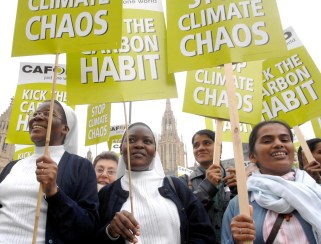
Nuns, monks, and clergy take part in a ‘kick the carbon habit’ protest, calling for political leaders to strengthen a climate change bill.
Clive Gee/ PA Images via Getty Images
Mental health professionals increasingly recognize the emotional toll of climate change, but psychologist Wendy Greenspun, a board member of the Climate Psychology Alliance—North America, thinks addressing it must go beyond individual therapy to include collective forms of care. “Clinicians will probably need to get more involved with building community sources of resilience,” she said on a recent Alliance podcast, “empowering people within communities who are already the natural leaders, who know the culture of that community, to be able to apply some of their skills to emergent crises that are coming up.”
Many of those people are, of course, clergy and other spiritual leaders. There is a growing feeling within religious circles that their leadership is essential. Mounting evidence supports the notion that it is needed. A study, published in The Lancet, of 10,000 young adults worldwide found that 75 percent of people between 18 and 25 find the future frightening. A 2022 survey by Yale University and George Mason University found that 65 percent of Americans are worried about global warming.
Dekila Chungyalpa, who has spent more than 20 years designing and implementing climate and conservation initiatives, saw deep interest in clergy engagement at a March retreat of American Buddhist leaders who apply environmental work to their dharma practice and chaplaincy. Many concerns came from leaders of color from the U.S. and the Global South who want to see greater involvement of, and better training for, spiritual leaders in addressing climate grief, she said. Because no one was providing that, she created the Loka Initiative at the University of Wisconsin-Madison’s Center for Healthy Minds in 2019. While not specifically focused on climate emotions, the initiative trains evangelical leaders on climate science and also has organized a global event of Indigenous elders and environmental experts.
Chungyalpa, who is of Bhutia origin from the Indian state of Sikkim, recognized the importance of religion after her own experience with eco-grief. In the mid-aughts while working on climate adaptation in the Mekong River region at the World Wildlife Fund, she and her peers began experiencing panic, anxiety, bad dreams, and other symptoms of post-traumatic stress disorder. At the time, conversations about eco-grief weren’t common. She later met the Karmapa, Ogyen Trinley Dorje, the head of the Kagyu sect of Tibetan Buddhism, who led her in a helpful meditation that could be tweaked for an environmentalist. Using Tonglen meditation, also known as “taking and sending,” he suggested she visualize taking the suffering of one part of the Earth or the whole planet and then sending it healing and well-being. After making it a regular practice and feeling the benefits of the perspective it provided, she began offering it to others.
“There are so many traditions that offer healing practices that we just don’t tap into because we’re uncomfortable with religion,” she said.
Yet 84 percent of the global population and 70 percent of US adults identify with religion. Chungyalpa thinks this is reason enough to consider the role of faith in climate responses. “[Faith leaders] are the perfect community leaders to hold people’s suffering and grief and help people to make sense of what is happening around them,” she said. As climate change makes the world less comfortable and people lose things they have taken for granted, they will need “chaplains to understand people’s emotions and be activated to anticipate it, to recognize it, to work with it,” she said.
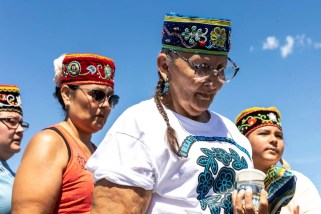
Indigenous Line 3 protesters pray for water during a rally and march in Solway, Minnesota on June 7, 2021.
Kerem Yucel/AFP via Getty Images
Keeping in mind how marginalized communities will disproportionately feel the effects of climate change, the Loka Initiative recently began research to understand which climate emotions manifest within them. “Our proximity to suffering will influence how we experience eco-anxiety and distress. It’s not a flat thing,” said Chungyalpa. The goal is to determine what types of contemplative practices, which can be rooted in several religious traditions, best support marginalized communities.
Panu Pihkala, a Lutheran pastor and environmental theologian at the University of Helsinki, advocates applying knowledge from ritual studies as we imagine what kinds of practices can help us deal with difficult emotions arising from climate stress.
Congregations can reorient practices that are already a part of regular services by adapting written liturgies or including climate in prayers. Houses of worship that follow seasonal worship calendars can also consider how, say, Lent or Ramadan can engage climate emotions. Clergy can also write liturgy for life’s milestones such as Shapiro’s baby naming ceremony.
Pihkala points out that our modern practices can link back to ancient religious rituals long attuned to ecological seasons, such as thanksgiving at harvest or blessing soil before planting. Or they can organize new events around familiar practices, such as public laments expressing grief through silent moments of reflection, songs, candles, and the like. What religions can offer is the sense that these feelings and the work of processing them are necessarily shared. “Broadly rituals make things more real in the public reality,” said Pihkala.
Shapiro, who has since moved to Auckland, New Zealand, agrees and offers the example of a wedding: A couple may be in a committed long-term relationship, but a wedding declares an intention to the state and one’s community. “Rituals are containers, very often of emotion, so they invite us to feel emotions deeply in a single instance. So, I may have been feeling all the love and connection with my partner, but standing under the chuppa [a canopy in Jewish weddings] together brings it all rushing forward,” he said.
The rituals that can help people cope with the impacts of climate change need not be specifically religious. California State University at Chico created a space for public grieving following the 2018 Camp Fire that killed 18 people and destroyed 18,000 buildings. Memorials akin to funerals have been held for glaciers, and Extinction Rebellion’s often performative protests incorporate art much like liturgical practices.
Whether religious or secular in nature, rituals play an important role in helping people process difficult emotions. Those related to climate may linger under the surface unbeknownst to a person, who may not even know that there is even a problem—something Shapiro calls a “low-grade infection.” But “when you name it and create the right space and atmosphere and bring in other people feeling similarly, you create a safe place for those deeper emotions to emerge,” he said.
Pihkala has written about how rituals acknowledge the connection between our minds and bodies through tangible actions like lighting a candle or dancing. Additionally, since environmental problems often feel daunting because of their abstractness, marking our emotions within local places and time-bound events help the situation feel more manageable.
In a new anthology, he recalls learning that the Finnish government clear-cut an ancient coniferous forest in 2015. “I read the news at home and was shocked. I had spent much time in this forest and knew about its significance both as an ecosystem and for people,” he wrote. In response, a couple dozen people gathered for a public lament modeled after a Christian funeral ceremony, for the loss of the forest.
What happened after Pihkala’s service taught him a lot about the power of such rituals. Those who came to say farewell to the forest stayed to discuss how to prevent anything like it from happening again. Their grief had morphed into anger. “Anger and outrage can motivate action,” he wrote.
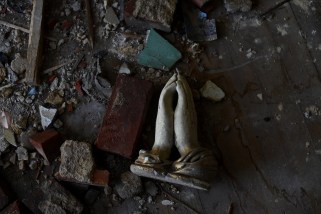
A prayer sculpture rests on the ground of a church that was damaged by a tornado in December 2021 in Mayfield, Kentucky.
Joshua Lott/The Washington Post via Getty Images
Scientific evidence supports that: In a survey of Australians who accept climate science, psychologists found that anger might be one emotion that can drive pro-environment engagement. Greenspun, the psychologist, encourages people to think of anxiety as a reasonable emotional response, one that should be acknowledged, then channeled toward positive action. To do so, though, people need avenues, such as rituals, to reflect, deliberate, and process anxiety before deciding what action to take.
“We think initially, ‘If I acknowledge my grief or despair or anxiety, I will shut down. I will say the whole thing is hopeless,’” said Jim Antal, a United Church of Christ minister and long-time climate activist. But “grief is what we have to go through. It’s the door we have to open in order to become an activist on the other side.”
Antal, like Shapiro, doesn’t see climate action as separate from religious practice. In 2016, he brought what he calls “liturgy to the streets” to a pipeline protest in the Boston neighborhood of West Roxbury. The interfaith rally included Christians, Hindus, Buddhists, and Jewish participants, who preached, prayed, quoted Scripture, and sang, before being arrested for civil disobedience.
Antal has been trying to activate Christian churches in the US for decades. While his own UCC denomination has often been the first to take climate action, many American evangelical churches have given climate science less attention than other issues. He feels churches face an imperative to build a culture that is transparent enough to talk about the climate crisis. Speaking about the reality of one’s climate emotions publicly validates them, said Antal, similar to how acknowledging mental illness openly has grown over time.
More religious leaders are seeing a role for themselves in an era of climate crisis. “I see a recognition among faith leaders and religious institutions that this needs to happen, and they are investing a lot more in capacity building,” said Chungyalpa, who gets a lot of calls from US-based divinity programs asking for help in adapting their pedagogy to address this reality.
As he went through his own awakening to our climate reality, Shapiro, like many people, felt powerless and overwhelmed. Having moved through those feelings, he’s ready to help clergy of all faiths re-shape old rituals that will help people survive and thrive in the future. His new interfaith course to prepare clergy to lead congregations through the challenges of climate change begins online in June at Blessed Tomorrow.
The program helps clergy include the environment within their sermons and notice where long-standing liturgy already recognizes the natural world. The goal is for clergy to realize the sustainability and resilience their communities can offer with the land resources and social capital that they already have. Out of that awareness, Shapiro thinks actions will flow.
He sees the garden at his congregation’s Auckland synagogue as both spiritual and natural. It provides habitat for pollinators, incorporates water-conserving plants, and provides produce for the local food bank. But its utility within the ecosystem is not separate from its importance as a place for prayer and reflection on scriptures. To Shapiro, when clergy realize the mutuality of those relationships, it will inform and sustain a rising climate consciousness.
“It is our sacred duty [as clergy] to help people process complicated feelings and choices through informed pastoral counseling and thoughtful ritual,” he said. “When we do, we help light the way forward.”
